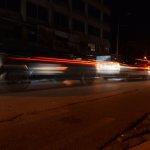5th Circuit on Texting While Driving
On Dec. 18, 2018, the United States 5th Circuit Court of Appeal spoke to the issue of whether a smartphone manufacturer could be held liable for failing to block the ping of a text message that distracted a Texas driver in 2013.
In Meador v. Apple, the court handed down a ruling in a lawsuit filed by the family of those injured in a distracted driving case. A woman was driving her pickup truck when she looked down to read a text message on her iPhone 5. The suit alleged she caused a collision that killed two adults and rendered a child paraplegic. The woman was ultimately convicted of two counts of criminally negligent homicide. The victims’ family sued Apple in federal court on grounds of negligence and strict product liability. The lawsuit alleged that Apple held a patent on a lockout mechanism that would have blocked the text message but the company failed to install it on the iPhone 5. They also claimed that Apple failed to warn iPhone users of the risks of distracted driving. The plaintiffs claimed that the receipt of a text message triggered an “unconscious and automatic neurological compulsion to engage in texting behavior.”
The appeals court noted that no court in Texas had addressed the issue of whether a smartphone manufacturer could be liable for a user’s actions because of a neurobiological response induced by its product. As a result, the court was placed in the position of having to predict how a Texas state court would rule in the case. The court analyzed various precedent cases and cited a 2017 Texas state law that criminalized reading, writing or sending a text message while driving.
“We therefore cannot say that Texas law would regard a smartphone’s effect on a user as a substantial factor in the user’s tortious acts,” the court ruled. The court then refused to consider neurobiological compulsion as a cause of the injuries.
It remains to be seen whether the plaintiffs will appeal the decision. One does wonder, however, why Apple did not install the blocking device on that particular version of the iPhone, especially society’s strong position against texting while driving.
We have written often about the dangers of texting while driving. There is no doubt that distracted driving creates a hazardous condition for the offending driver, passengers and other vehicles who may be nearby.
Distracted driving has resulted in countless rear-end collisions with injuries, even fatal accidents. The attorneys at the law firm of Joseph Joy and Associates have decades of experience litigating rear-end collisions. Joseph Joy automobile accident attorneys are filing more and more personal injury lawsuits against drivers who were texting, not paying attention and causing serious car wrecks.
Louisiana law has a similar penalty for smartphone users who text while driving:
RS 32:300.5 — Use of certain wireless telecommunications devices for text messaging prohibited
A.(1) Except as provided in Subsection B of this Section, no person shall operate any motor vehicle upon any public road or highway of this state while using a wireless telecommunications device to write, send, or read a text-based communication. For purposes of this Section, a person shall not be deemed to be writing, reading, or sending a text message if the person reads, selects, or enters a telephone number or name in a wireless telecommunications device for the purpose of making a telephone call.
(2)(a) “Wireless telecommunications device” means a cellular telephone, a text-messaging device, a personal digital assistant, a stand alone computer, or any other substantially similar wireless device that is readily removable from the vehicle and is used to write, send, or read text or data through manual input. A “wireless telecommunications device” shall not include any device or component that is permanently affixed to a motor vehicle. It does not include citizens band radios, citizens band radio hybrids, commercial two-way radio communication devices, or electronic communication devices with a push-to-talk function.
(b) “Write, send, or read a text-based communication” means using a wireless telecommunications device to manually communicate with any person by using a text-based communication referred to as a text message, instant message, or electronic mail.
- The provisions of this Section shall not apply to the following:
(1) Any law enforcement officer, firefighter, or operator of an authorized emergency vehicle while engaged in the actual performance of his official duties.
(2) An operator of a moving motor vehicle using a wireless telecommunications device to:
(a) Report illegal activity.
(b) Summon medical or other emergency help.
(c) Prevent injury to a person or property.
(d) Relay information between a transit or for-hire operator and that operator’s dispatcher, in which the device is permanently affixed to the vehicle.
(e) Navigate using a global positioning system.
(3) A physician or other health care provider using a wireless telecommunications device to communicate with a hospital, health clinic or the office of the physician, or to otherwise provide for the health care of an individual or medical emergency through a text-based communication.
C.(1) The first violation of the provisions of this Section shall be punishable by a fine of not more than one hundred seventy-five dollars.
(2) Each subsequent violation shall be punishable by a fine of not more than five hundred dollars.
(3) If the person is involved in a crash at the time of violation, then the fine shall be equal to double the amount of the standard fine imposed in this Subsection and the law enforcement officer investigating the crash shall indicate on the written accident form that the person was using a wireless telecommunications device at the time of the crash.
(4) Any violation of this Section shall constitute a moving violation.
Acts 2008, No. 665, §1, eff. July 1, 2008; Acts 2010, No. 203, §1.
According to the Louisiana Highway Safety Commission, driver distraction is a contributing factor in many crashes. In Louisiana, 192 people were killed from 2011-2015 because of some distraction either inside or outside the vehicle, and another 26,977 people were injured.
A driver who takes his or her eyes off the road for a single second can travel several feet. For example, a car traveling 65 mph travels 95 feet per second. (Formula: convert 65 miles per hour to feet per second. One Mile is 5280 feet. 65 miles is 343,200 feet per hour. Divide by 3600 (3600 seconds in an hour). Answer: 95 feet per second).
Loss of life and personal injury is the ultimate price to pay for vehicular accidents. At Joseph Joy and Associates, our personal injury attorneys have recovered millions for clients and their families who have suffered damages due to someone else’s negligence. If you have the unfortunate experience of being seriously injured by a driver who was texting just before a collision, or if you were in an accident involving a negligently operated car, truck or big rig, give us a call: 337-232-8123 or visit us at 900 S. College Rd., Ste. 204, Lafayette, LA.




